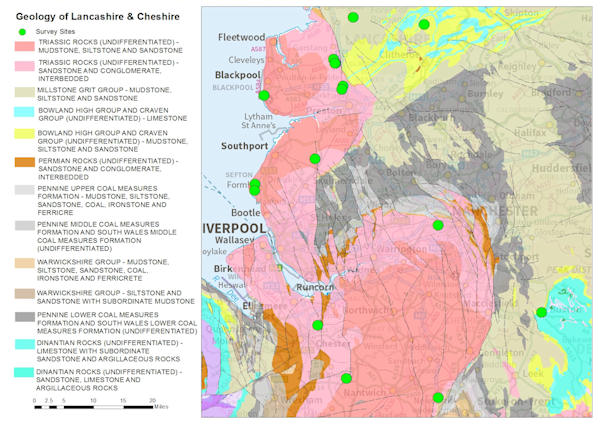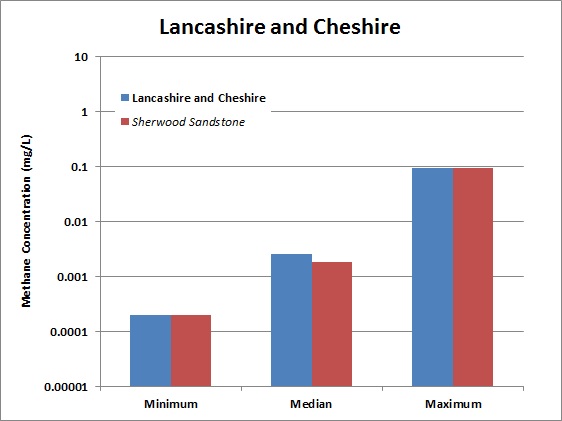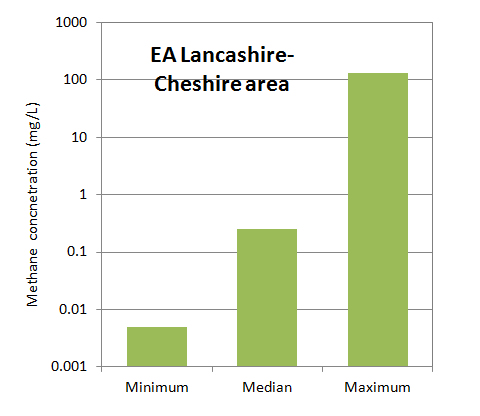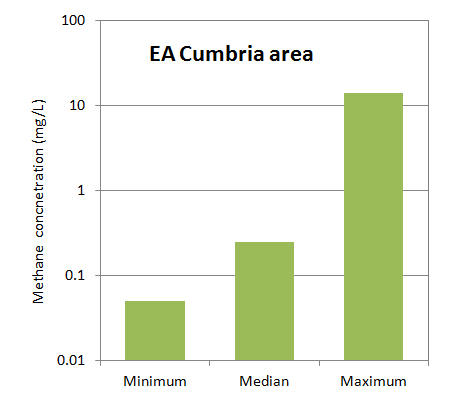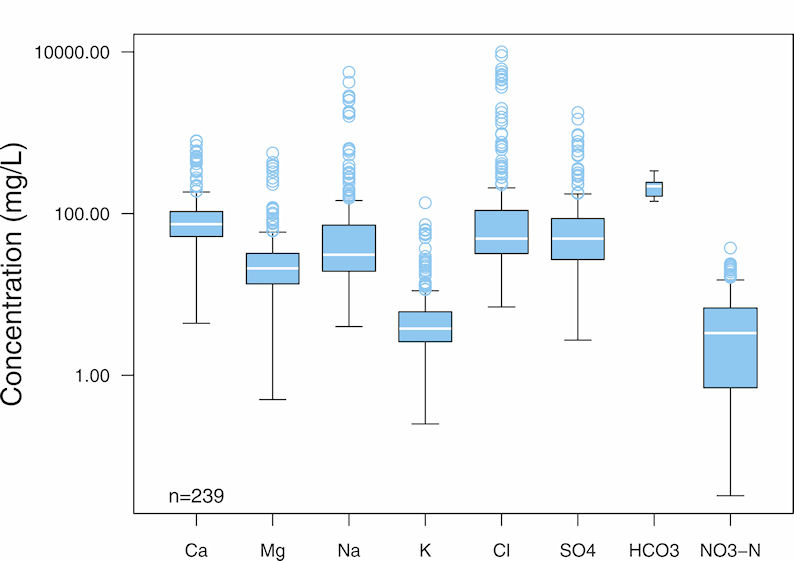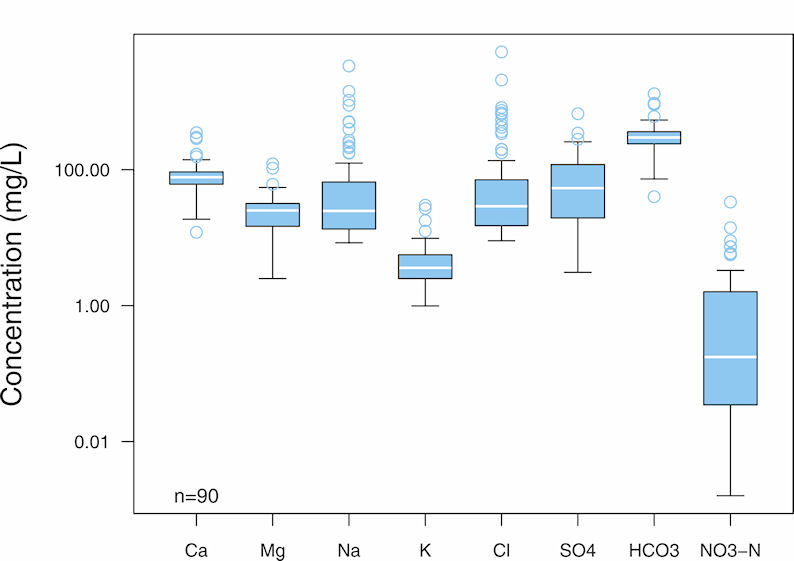Lancashire and Cheshire Basins
Regional summary
In Lancashire and Cheshire, 23 sites have been sampled for methane in three aquifers, the main aquifer being Permo-Triassic sandstone. The Environment Agency also holds extensive methane data across the region.
- Permo-Triassic sandstone forms an important aquifer in this region, used extensively for public water supply. Groundwater flow occurs mainly through pore spaces in the rock due to its high porosity, although the presence of fractures is also important. Permo-Triassic sandstone is at the surface along the Lancashire coast and can be up to 600 m thick.
- The two other aquifers sampled for methane are the Millstone Grit and other shallow sand deposits. These are classed as secondary B aquifers and are not used for public water supply.
The shale units present in this area are the Bowland and Craven Groups, which are organic rich mudstones. In the Cheshire Basin, the shale is at its deepest, reaching depths of over 6000 m below OD. The Bowland and Craven Groups are reported to have potential to form a shale gas resource, although this is complicated by Britain's complex tectonic history (Andrews, 2013).
Methane in UK groundwater results
These summaries are based on the results collected from single visits to each site for the purpose of the methane baseline project. The data are summarised for Lancashire and Cheshire as a whole, and also for individual aquifers, where enough data are available.
The blue boxes highlight where summary data are available for baseline groundwater quality in the different aquifers present in this region, and link to the summaries for each region.
| Area | Concentration (mg/l) | Number of Samples |
||
|---|---|---|---|---|
| Minimum | Median | Maximum | ||
| Lancashire and Cheshire | 0.0002 | 0.0025 | 0.091 | 23 |
| Sherwood Sandstone | 0.0002 | 0.0018 | 0.091 | 10 |
Environment Agency methane data
Additional methane data is available from monitoring carried out by the Environment Agency (EA), North West Region, between 1985 and 2012. This sampling was done for different reasons, such as landfill monitoring. Many of the values represent multiple analyses of samples from the same site. The data have been separated into two regions: Lancashire-Cheshire and Cumbria.
| Area | Concentration (mg/l) | Number of samples |
||
|---|---|---|---|---|
| Minimum | Median | Maximum | ||
| Lancashire-Cheshire | <0.01 | <0.5 | 132 | 2842 |
| Cumbria | <0.1 | <0.5 | 14.2 | 836 |
Baseline groundwater quality data in the Permo-Triassic sandstone of Cheshire
A summary of the baseline quality of groundwater in the Permo-Triassic sandstone of Cheshire is below. These data were collected as part of a collaborative project between BGS and the Environment Agency to investigate the baseline quality of groundwater in major UK aquifers. The UK baseline study results page provides downloads of all the reports produced by the project.
| Area | Concentration (mg/l) | Number of samples |
||
|---|---|---|---|---|
| Minimum | Median | Maximum | ||
| Ca | 4.4 | 74 | 795 | 239 |
| Mg | <1 | 21 | 562 | 239 |
| Na | 4 | 31 | 5600 | 243 |
| K | 0.25 | 3.75 | 136 | 242 |
| Cl | 7 | 49 | 10000 | 244 |
| SO4 | <4 | 49 | 1780 | 240 |
| HCO3 | 142 | 218 | 338 | 23 |
| NO3.N | <0.05 | 3.3 | 37.5 | 246 |
The quality of groundwater in the Permo-Triassic sandstone is determined by natural reactions between rainwater and the bedrock, which creates a variable baseline. Chemical reactions take place during recharge, the most important being mineral dissolution and precipitation. The baseline in Lancashire and Cheshire has been modified by diffuse pollution including agricultural fertilisers, which has led to locally high levels of nitrate (NO3.N), potassium (K) and sodium (Na). Along the Mersey estuary, the ingress of saline water also has an impact on groundwater chemistry.
Baseline groundwater quality data in the Permo-Triassic sandstone in Manchester
A summary of the baseline quality of groundwater in Permo-Triassic sandstone in Manchester is presented below. These data were collected as part of a collaborative project between BGS and the Environment Agency to investigate the baseline quality of groundwater in major UK aquifers. The UK baseline study results page provides downloads of all the reports produced by the project.
| Area | Concentration (mg/l) | Number of samples |
||
|---|---|---|---|---|
| Minimum | Median | Maximum | ||
| Ca | 12 | 86.2 | 350 | 90 |
| Mg | 2.5 | 26.8 | 122 | 90 |
| Na | 8.4 | 133 | 3360 | 90 |
| K | 0.99 | 4.85 | 30 | 90 |
| Cl | 9 | 185 | 5400 | 88 |
| SO4 | <5 | 82.9 | 666 | 90 |
| HCO3 | 40 | 316 | 1310 | 89 |
| NO3.N | <0.003 | 1.61 | 33.4 | 90 |
| Fe | <5 | 1050 | 9600 | 85 |
The groundwaters of the Permo-Triassic aquifer of Manchester display a wide range of chemical characteristics with concentrations for most elements varying over several orders of magnitude. These characteristics are determined largely by natural reactions between the groundwater and the rocks through which it passes. This baseline has been modified by diffuse pollutants including agricultural fertilisers leading locally to high nitrate (NO3.N) and increases in other major elements such as potassium (K), sodium (Na) and sulphate (SO4). Most chemical parameters are highly variable due to the complex geology and the presence of drift deposits, which differ in thickness and type. These drift deposits have a significant effect on recharge of the aquifer but provide a degree of protection from diffuse or point source pollution.
Contact
Please contact BGS Enquiries for more information.


